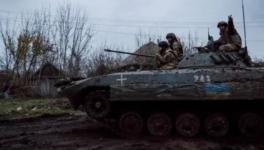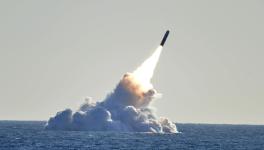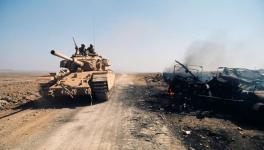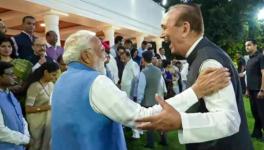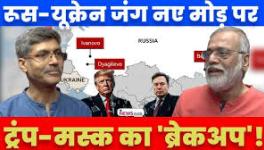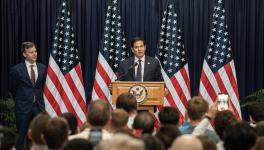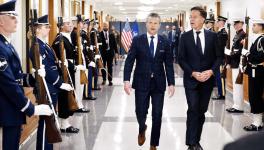Pentagon-Funded Think Tank Red-Flags America’s Ukraine Policy
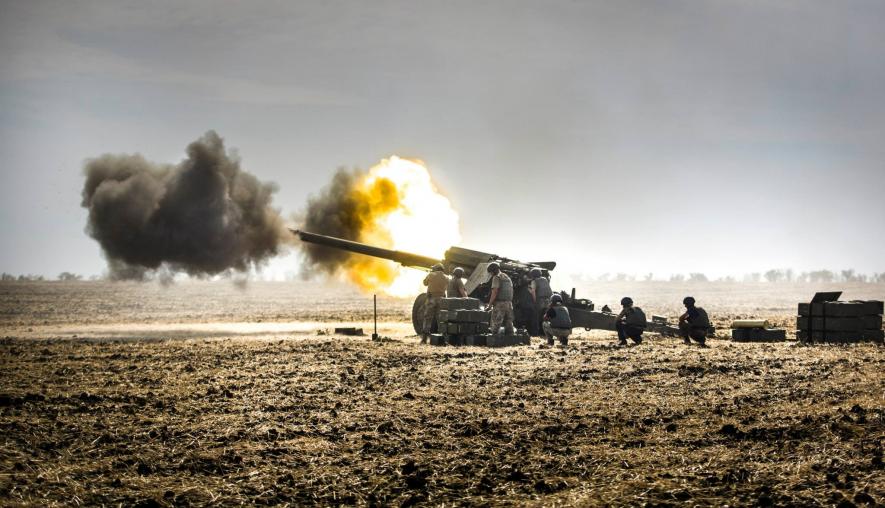
Representational Image. Image Courtesy: Wikimedia Commons
The United States (US) has announced another arms package, including the 145-km range guided missile Ground-Launched Small Diameter Bomb, worth around $2.2 billion for Ukraine as the grinding war with Russia completes one year on February 24.
Out of the nearly $48 billion US aid for Ukraine in 2022, $24.9 billion was spent on weapons, according to American think tank Council on Foreign Relations (CFR). The aid is besides the $13 billion committed by NATO, the European Union (EU) and other allies to Ukraine.
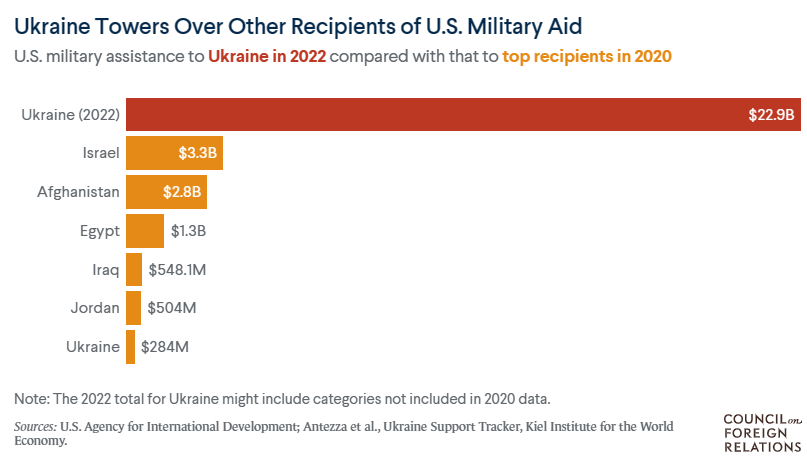
The supply of military equipment worth billions to Ukraine in the name of protecting democracy and the liberal world order with no sight of an end to the war—which could escalate to use of nukes or a Russia-NATO confrontation—is ridiculous and inexplicable.
This is precisely what a RAND Corporation report has pointed out—avoid a long conflict in Ukraine to prevent a nuclear or Russia-NATO war.
Shockingly, the western media, except The Washington Post, never mentioned the report. What’s more shocking is that RAND is majorly funded by the US government, especially the Pentagon. Out of the $346 million revenue earned by the non-profit global policy think tank in the financial year 2021, 19.4% came from the office of the secretary of defence and other national security agencies, 11.3% from the Army and 10.5% from the Air Force.
The report, ‘Avoiding a Long War: U.S. Policy and the Trajectory of the Russia-Ukraine Conflict’, flags President Joe Biden and secretary of state Anthony Blinken’s “We will support Ukraine as long as it takes” rhetoric and fallacy.
We will stand with Ukraine for as long as it takes. A tough winter lies ahead for Ukrainians, and we will work tirelessly with the G7 and other partners to repair, replace, and defend Ukraine’s energy infrastructure. https://t.co/bdWMW31ux8
— Secretary Antony Blinken (@SecBlinken) December 27, 2022
USE OF NON-STRATEGIC NUKES
RAND frighteningly raises the plausibility of Moscow using nonstrategic nuclear weapons (NSNW) even as “some analysts have dismissed the possibility of NSNW use contending that Russia knows that employment of nuclear weapons would be self-defeating”.
Experts contend that President Vladimir Putin won’t use NSNWs due to the “lack of concentrated Ukrainian forces”, and the risk of “harming” Russian troops, drawing NATO into the war and further global opprobrium.
The report, however, considers the use of nukes “both a plausible contingency that Washington needs to account for and a hugely important factor in determining the future trajectory of the conflict”.
Once other conventional escalatory options have been “exhausted, Moscow may resort to nuclear weapons, and specifically NSNW use, to prevent a catastrophic defeat,” RAND says.
Stating that some Russian strategists have advocated the use of NSNWs for “accomplishing operational and tactical goals”, the report adds that they have also envisioned “pre-emptive employment of NSNWs against civilian targets—cities, military-industrial centres and government facilities—and against military ones, at least, in the context of a war with NATO”.
NATO-RUSSIA WAR
Since the US has signalled retaliation if Russia uses N-weapons, it “might lead to a tit-for-tat spiral that produces a NATO-Russia war” and could “lead to a direct US conflict with Russia, which could ultimately result in a strategic nuclear exchange”.
The risk of a nuclear or Russia-NATO war will “remain heightened” as long as the war continues, the report says.
Citing the November 2022 example of a Ukrainian S-300 missile landing in Poland, the report highlights the risk of an “inadvertent escalation” and fighting “unintentionally” spilling over to the territory of neighbouring NATO members even if Russia doesn’t use a nuke.
“A future targeting error could send a Russian missile into NATO territory, potentially sparking an action-reaction cycle that could lead to a full-scale conflict.”
In fact, Chairman of the Joint Chiefs of Staff Mark A Milley had warned the Biden administration way back in October 2021 that the number one objective should be to avoid a “kinetic conflict between the US military and NATO with Russia”.
Despite Milley’s warning, the US fears that the war could lead to a direct confrontation with Russia—at least, that is what the annual NATO winter exercise of Baltic nations mimicking war with Russia indicates.
The massive drill in Estonia, only 100 miles from the Russian border and intended to gel Estonian, French, British, Danish and US troops as a singular fighting force, involves Danish Leopard 2 and British Challenger 2 tanks.
LOW US WEAPONS STOCKS
The RAND report also mentions that military assistance could become “unsustainable” after a certain period if the war is prolonged with American weapons stocks reportedly low.
For example, the US has so far supplied around 1,600 Stinger missiles, whose manufacturer Raytheon has restarted manufacturing them now after ceasing production in 2003. A report issued by the department of defence last year shows that the US depends on only five prime arms contractors now as against 51 in the 1990s.
As per CFR, out of top 20 donors to Ukraine as of November 20, 2022, the US was at the top, followed by EU institutions, the UK, Germany, Canada and Poland.
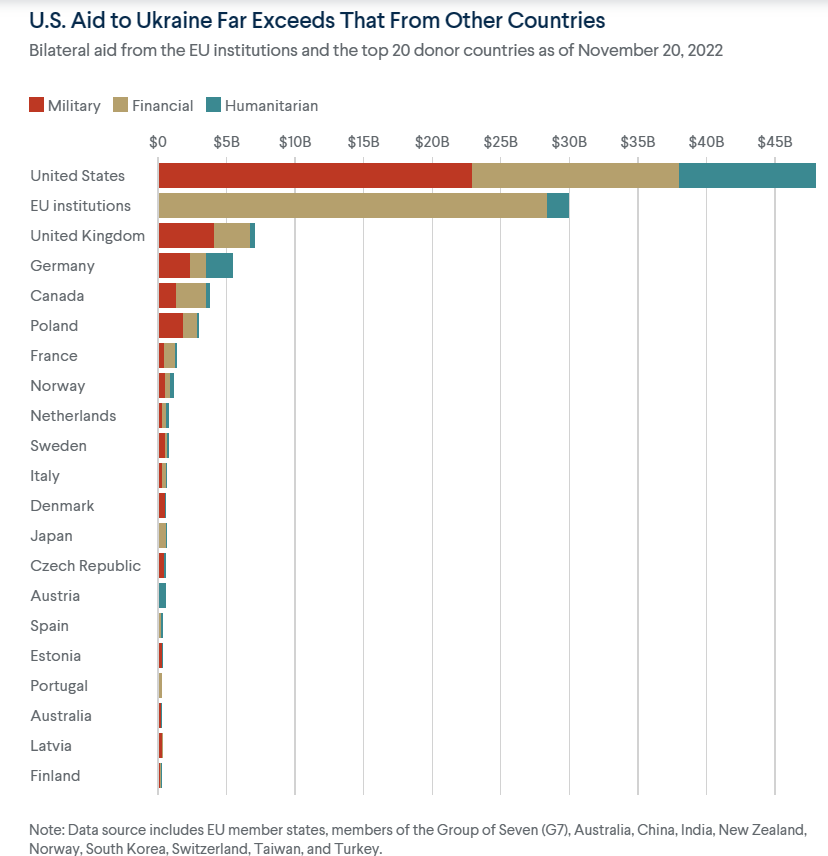
“This is a war we thought would be over in days but now could be years. At a time when global supply chains are melting down, the West is going to have a very difficult time to meet demands at this very high level,” Illinois representative Mike Quigley, a member of the House Intelligence Committee, told CNN last November.
A protracted conflict will also damage US-Russia ties and impede cooperation—renewal of the New START (further reduction and limitation of strategic offensive arms), which expires in February 2026, and “cripple” the UNSC and non-proliferation efforts.
GLOBAL ECONOMIC IMPACT
RAND also argues that global economic disruptions caused by the war will “continue and possibly multiply” if it continues. “The outbreak of war caused a sharp increase in energy prices that has in turn contributed to inflation and slowing economic growth globally. These trends are expected to hit Europe hardest.”
Highlighting the rising food insecurity, caused by extreme weather and the pandemic, the report says that Ukraine’s exports of grains and oilseeds “dropped to 50%-70% of their pre-war levels between March and November 2022 partly because of Russia’s naval blockade and attacks on energy infrastructure”. “Russia has also restricted its own exports of fertiliser”, resulting in a large increase in food and fertiliser prices globally.
IMF managing director Kristalina Georgieva warned in January that “one-third of the world economy would be in recession” this year.
“Half of the European Union will be in recession. Even countries that are not in recession, it would feel like a recession for hundreds of millions of people,” due to pressure from the war and rising interest rates and prices, which will affect the US, Europe and China she said on CBS’s Face the Nation.
According to CFR, east European nations are donating most to Ukraine by share of GDP with Estonia at top, followed by Latvia, Poland, Lithuania and Norway—the US is at the 9th position. Clearly, it won’t be possible for Europe to continue assisting Ukraine with the looming recession.
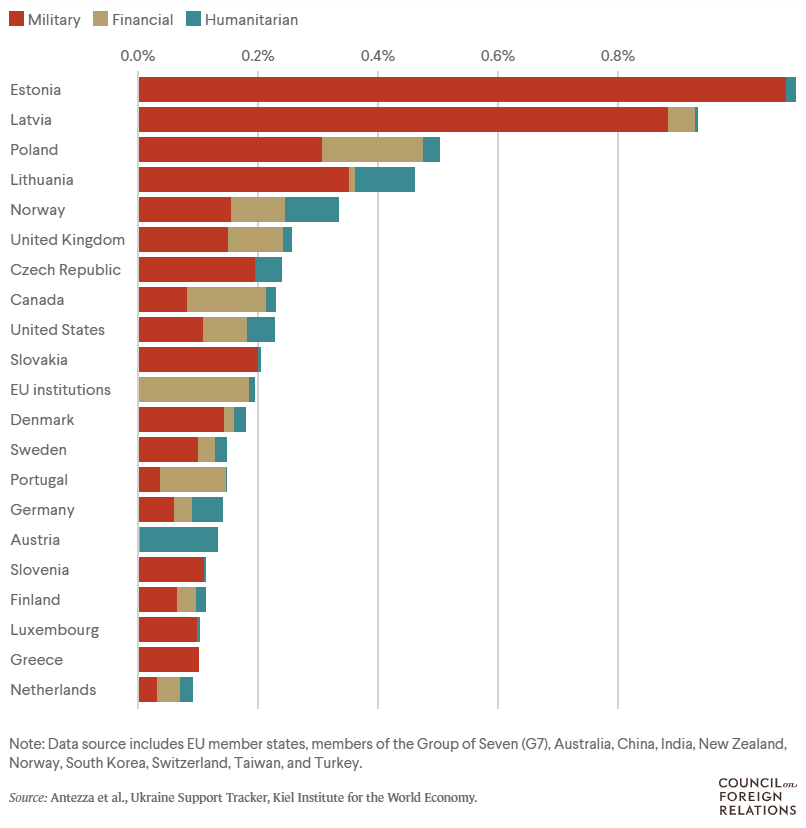
NO ABSOLUTE VICTORY BUT ONLY SETTLEMENT
The report rules out an absolute Ukrainian victory referring to Milley’s November 2022 news conference, where he said that the chances of any “near-term, outright military victory defined as kicking the Russians out of all of Ukraine” were “not high”.
Logically, such a victory is only possible if the entire Russian Army collapses—which is unlikely. Ukraine’s success in Kharkiv and Kherson are minor considering they are small portions of the geographically vast country.
Even Russia has apparently abandoned the plan of installing a new Ukrainian regime, demilitarising its adversary and retaking Kyiv. “Moscow’s primary goal seems to be holding onto territory in the four Ukrainian regions that Russia now claims as its own. But even if Russia took and held those regions, that would hardly be an absolute victory,” the report says.
“Since neither side appears to have the intention or capabilities to achieve absolute victory, the war will most likely end with some sort of negotiated outcome.”
A political settlement or peace treaty, according to RAND, would involve “both a durable ceasefire and a resolution of, at least, some of the disputes that sparked the war or emerged during it”. Russia’s main demand would be Ukraine’s “nonalignment” while the latter would want “reinforced” western commitments to its security.
The crux of such a settlement would be the restoration of normal relations between Russia and Ukraine to an extent despite disagreements about the status of certain territories. Since a political settlement is more “more durable” than an armistice, as it “addresses grievances on both sides and core issues in dispute between them”, it could reduce the chance of a Russia-NATO crisis in the future.
“In the case of the Russia-Ukraine war, a settlement also might open the door to a broader negotiation of rules of the road for regional stability that could mitigate the prospects of conflict breaking out elsewhere along Russia’s periphery.”
On the other hand, an armistice would end active combat with Russia not trying to occupy more Ukrainian territory and stopping missile strikes while Ukraine ceasing counteroffensives.
Ongoing territorial disputes will continue but they “would be contested politically and economically, not militarily”. “The line of control would likely become highly militarised like the inner German border during the Cold War,” the report says.
In such a scenario, the US should try to convince Ukraine and Russia to accept a “negotiated settlement somewhere between” a political pact and an armistice.
“In short, the consequences of a long war—ranging from persistent elevated escalation risks to economic damage—far outweigh the possible benefits,” RAND argues.
Linking the war’s duration with escalation, the report argues that though the probability of such a confrontation is “not high”, it is “plausible due to the circumstances created by the war”.
“The negative consequences of a long war would be severe. So long as the war is ongoing, escalation risks will remain elevated. Duration and escalation risks are thus directly linked,” it says adding that “avoiding them should remain the top US priority”.
The report acknowledges the impossibility of a “dramatic, overnight shift in US policy” but calls for eventually starting “a process that could bring this war to a negotiated end in a time frame that would serve US interests”. The alternative is a “long war that poses major challenges for the United States, Ukraine and the rest of the world.”
FLAWED AMERICAN LOGIC
Even if the report’s logicality is dismissed—as apparently done by Washington—the theory of arming Ukraine to the teeth without negotiating peace with Russia is flawed.
First, Russia never intended to expand westwards in Ukraine with NATO members Poland, Slovakia, Hungary and Romania flanking the western border—it would be suicidal to take on even the alliance’s conventional forces. Besides, Moscow would ever attempt a similar aggression against any other European nation in future considering its limited success in Ukraine.
Instead, NATO had reneged on its verbal assurance to then-Soviet Union President Mikhail Gorbachev of not expanding eastwards following the collapse of the Berlin Wall and the subsequent dissolution of the Warsaw Pact.
There’s a colossal gap between the military spending of the US and Russia. According to the Stockholm International Peace Research Institute, US spent a staggering $801 billion in 2021, a decline of 1.4% from 2020, as against Russia’s only $65.9 billion, a 2.9% rise from 2020.
Second, the US logic for supporting Ukraine to deter aggressions by powerful nations against weak ones is flawed as well. By the same logic, the US is the global police who should intervene in every war. The American motive is clear: to bleed Russia and expand the NATO alliance further eastwards.
Third, Blinken’s argument that Russia is testing the so-called “liberal international order” and is a threat to democracy is ludicrous.
The US invaded and occupied Iraq and Afghanistan for years and damaged them permanently, deposed democratically elected leaders in Iran, Chile and several other nations and turned a blind eye to the violation of democratic rights in Poland, Hungary, Turkey and Pakistan. The US defends a country only to advance its interests. Period!
Even the number of Americans who think that the US is providing too much support to Ukraine has increased. According to a Pew Research Center survey conducted from January 18 to 24 among 5,152 adults, 26% feel that the US is providing too much support, up 6 percentage points since last September and 19 points after Russia invaded Ukraine.
Besides, the partisan gap over whether the Russian invasion poses a major threat to US has widened. From 51% of Republicans and 50% of Democrats in March, the gap has increased to 29% vs 43%.
A Wall Street Journal survey conducted from October 22 to 26 among 1,500 Americans showed that around 30% think that the US is doing too much to support Ukraine, up from 6% in since March.
Get the latest reports & analysis with people's perspective on Protests, movements & deep analytical videos, discussions of the current affairs in your Telegram app. Subscribe to NewsClick's Telegram channel & get Real-Time updates on stories, as they get published on our website.










